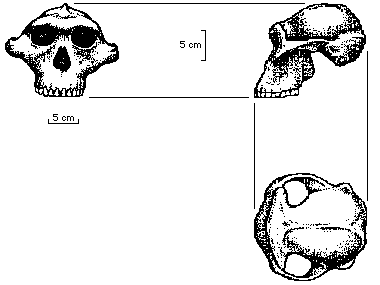

The scientific name for this species means robust Southern ape-man. Specimens of this species were also found in South African caves. An extremely robust variant of this species was found by Mary Leakey in 1959. Originally named Zinjanthropus by Louis Leakey, it has since been taxonomically reevaluated and placed within the species Australopithecus boisei. It is often lumped with the other, more typical, robust australopithecines, and is believed to have lived between 1.8 and 1 mya.
Note the very heavy cheek bones (zygomatic arches), the heavy brow ridges, the crest along the centerline of the cranium (sagittal crest), and the huge openings for the masseter muscles. Called the "human cuisinart" by Alan Walker, these features, in combination with the very heavy, and heavily enameled teeth have lead paleoanthropologists to believe that this species was adapted to a diet of tough vegetable foods and seeds, much like the similarly equipped gorilla is today. The similarities of A. robustus to A. africanus include bipedalism and a like body size.
| |
|
|